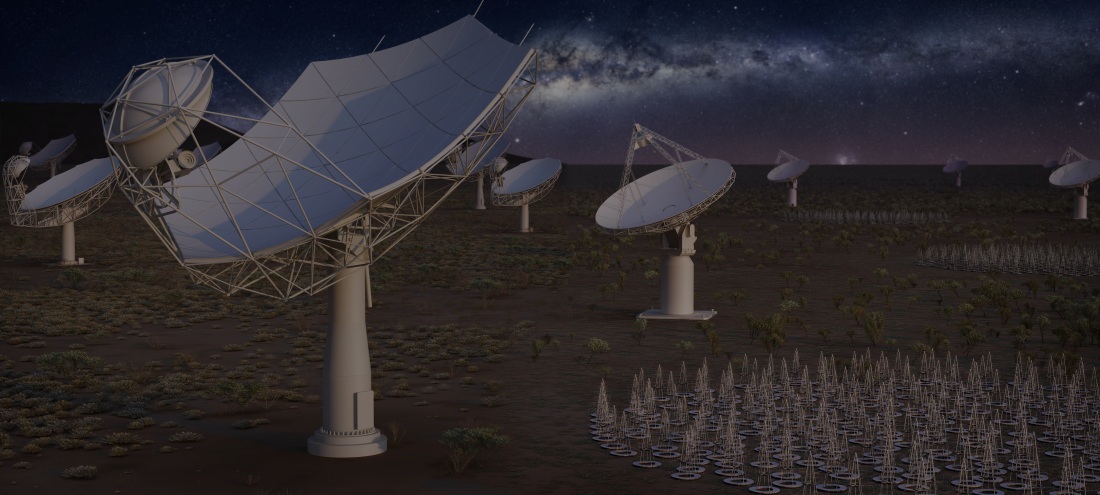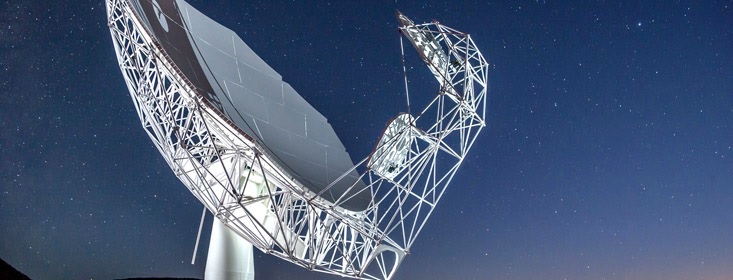5.13.16
No writer credit found

SKA dishes final design
An artist impression of the full SKA at night, with the selected Panel Space-frame supported Metal (PSM) SKA dish design in the foreground.
[Unless the dish in the foreground of this photo is the final selection, we do not actually find any other image of the final selection.]
SKA Global Headquarters, UK – The Square Kilometre Array (SKA) Project has selected the design for its dish, opening up the way for the eventual production of hundreds of dishes that will make up the world’s largest radio telescope.
“This decision is a major milestone towards delivering the SKA,” said Alistair McPherson, Head of Project at SKA Organisation “Being able to “see” what the SKA dishes will look like for the first time is a big satisfaction for all involved.”
Three antenna concepts were built to be considered for the design of the SKA dish: DVA-1 in Canada, DVA-C in China, and MeerKAT-1 in South Africa. All three were constructed using different technology from the different partners, representing the very best in radio telescope dish technology currently available.

DVA-1 in Canada

DVA-C in China
A five-strong selection panel of engineering experts in the fields of composites, radio telescope antennas and systems engineering assessed both designs on a series of indicators including surface accuracy, feasibility of on-site manufacturing and ability to maintain structural integrity over long time-frames and made a unanimous recommendation that the Chinese PSM concept should be selected for the SKA dishes, a recommendation that was then approved by the SKA Dish Consortium Board.
The SKA Dish Consortium, made up of institutes from Australia (who leads the consortium), Canada, China, Germany, Italy and South Africa is responsible for the design and verification of the dish that will make up SKA-mid, one of two SKA instruments. In its first phase of deployment (SKA1), SKA-mid will be initially composed of 133 15-metre diameter dishes providing a continuous coverage from 350 MHz to 14 GHz.
One of the greatest challenges faced by the consortium is the mass production of hundreds of these dishes, all with identical performance characteristics, and built to last and tolerate the harsh conditions of the remote arid areas in which they will operate for 50 years. Combined with achieving a large high precision collecting area at a competitive price, it’s a formidable technical and engineering challenge.
“We’re confident the selected design will perform well in the harsh conditions of the Karoo in South Africa and will deliver the precision that the scientific community needs to answer the questions they’re trying to solve” said Roger Franzen, SKA Dish Consortium Lead.
“The next step for us is to build and test a prototype at the South African site” he continued.
The detailed design and manufacturing of such prototype, called SKA-P, is led by JLRAT/CETC54 in collaboration with the European companies MTM and Società Aerospaziale Mediterranea (SAM), and the Assembly, Integration and Verification of SKA-P will be done on site together with SKA SA team.
“We expect the installation of SKA-P on the ground to happen by spring 2017”, said Roger Franzen. “Once satisfied with its performance, the project will be in a good position to go to tender and issue the contract for the mass production of 133 dishes to make up SKA1-mid.”
Beyond the design of the dish structure, the consortium is also tasked with designing and testing optics, receivers and other elements of the dish. As part of that process, NRC continues its valuable contributions to single pixel feed (SPF) receivers/digitizers and cryogenic low noise amplifiers (LNAs).
About the Design process
In 2013, the SKA Organisation sent out requests to research organisations and commercial partners around the world to help design the SKA. Eleven international teams – called consortia – were established and each tasked with designing a critical element of the project, with each consortium composed of partners who are leaders in their fields.
The consortium then presented the following designs for study:
An innovative Single Skin, Rim supported Composite (SRC) concept led by the National Research Council of Canada (NRC), along with SED Systems of Canada and RPC Composites of Australia.
An optimised Panel, Space-frame supported Metal (PSM) concept, led by a Shijiazhuang, China based team composed of JLRAT/CETC-54 along with their European partner, MT Mechatronics (MTM) of Mainz, Germany
See the full article here .
Please help promote STEM in your local schools.
![]()

SKA ASKAP Pathefinder Telescope

SKA Murchison Wide Field Array
About SKA
The Square Kilometre Array will be the world’s largest and most sensitive radio telescope. The total collecting area will be approximately one square kilometre giving 50 times the sensitivity, and 10 000 times the survey speed, of the best current-day telescopes. The SKA will be built in Southern Africa and in Australia. Thousands of receptors will extend to distances of 3 000 km from the central regions. The SKA will address fundamental unanswered questions about our Universe including how the first stars and galaxies formed after the Big Bang, how dark energy is accelerating the expansion of the Universe, the role of magnetism in the cosmos, the nature of gravity, and the search for life beyond Earth. Construction of phase one of the SKA is scheduled to start in 2016. The SKA Organisation, with its headquarters at Jodrell Bank Observatory, near Manchester, UK, was established in December 2011 as a not-for-profit company in order to formalise relationships between the international partners and centralise the leadership of the project.
The Square Kilometre Array (SKA) project is an international effort to build the world’s largest radio telescope, led by SKA Organisation. The SKA will conduct transformational science to improve our understanding of the Universe and the laws of fundamental physics, monitoring the sky in unprecedented detail and mapping it hundreds of times faster than any current facility.
Already supported by 10 member countries – Australia, Canada, China, India, Italy, New Zealand, South Africa, Sweden, The Netherlands and the United Kingdom – SKA Organisation has brought together some of the world’s finest scientists, engineers and policy makers and more than 100 companies and research institutions across 20 countries in the design and development of the telescope. Construction of the SKA is set to start in 2018, with early science observations in 2020.



